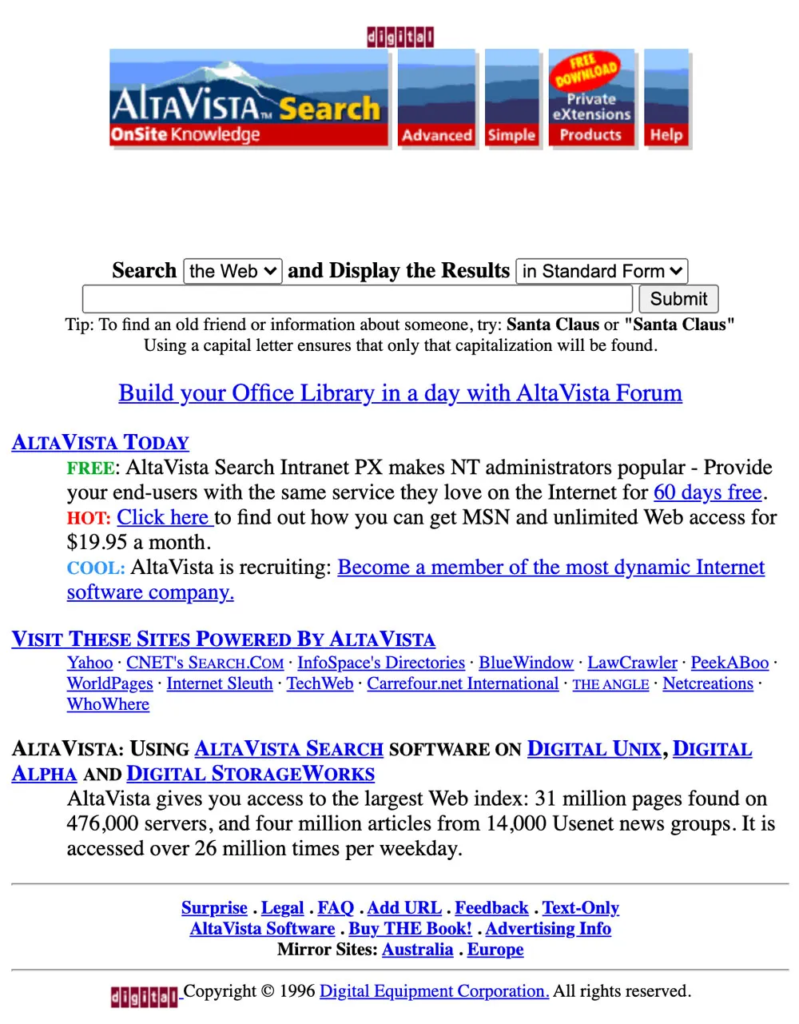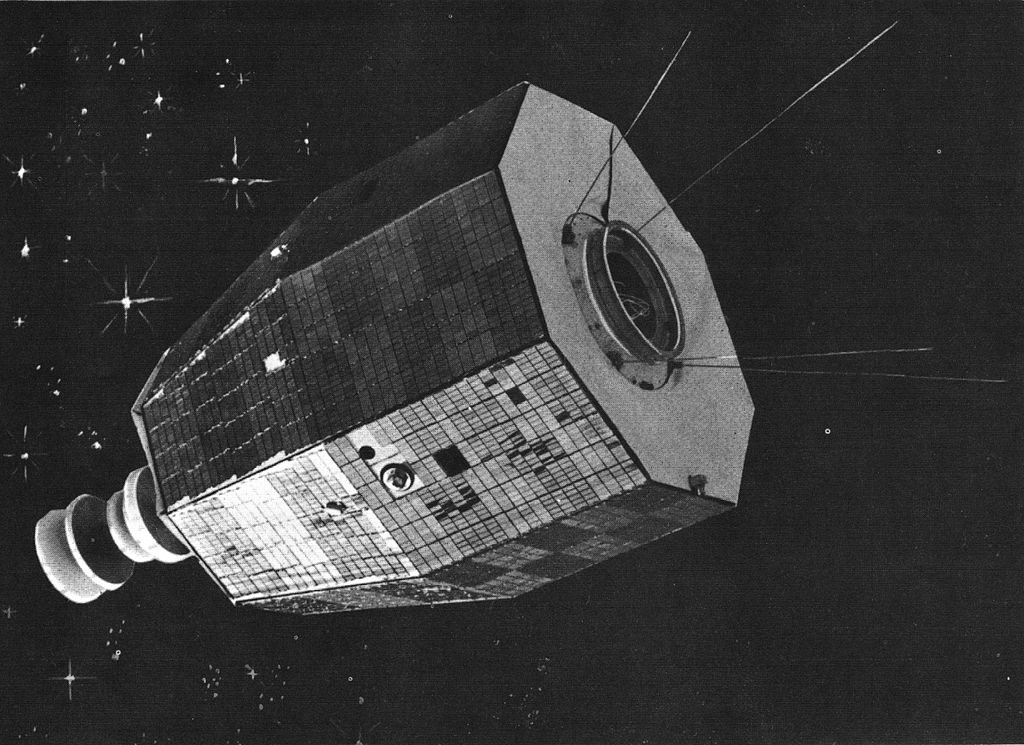Once hailed as a pioneering force in the world of search engines, AltaVista has gradually faded into the pages of internet history. During the late 1990s, AltaVista stood as a formidable tool for users navigating the expansive digital landscape. This blog embarks on an exploration of AltaVista’s captivating journey, unravelling its inception, period of dominance, subsequent decline, and enduring influence on the evolution of search engines.
Table of Contents
Prior to delving into the blog’s narrative, it’s essential to address some key questions.
Does the AltaVista search engine still exist?
No, the AltaVista search engine ceased to exist on July 8, 2013, when Yahoo! officially shut down the service. Since then, attempts to access AltaVista have redirected users to Yahoo!’s search site in the United States. The closure marked the end of AltaVista’s once-prominent role as a pioneering search engine, and its domain was absorbed into the larger landscape of Internet history.

Why did AltaVista fail?
AltaVista faltered due to a strategic error as its focus on search dwindled. The critical misstep arose from CMGi’s overarching goal of internet domination through acquisitions, sidelining the refinement of AltaVista’s core product. The shift in top-level business strategy proved detrimental, leading to a loss of competitive edge in the rapidly evolving search engine landscape. As Google surged ahead with continuous innovation, AltaVista’s stagnation, coupled with changes in ownership, resulted in a decline that marked the end of its once trailblazing presence in the digital domain.
What did Google do to AltaVista?
Google outpaced AltaVista through continuous innovation and strategic adaptability. Google introduced new services, expanded its product offerings, and consistently refined its search algorithm. Meanwhile, AltaVista faced stagnation, failing to keep pace with the dynamic demands of users and the evolving digital landscape. Google’s commitment to improvement, coupled with AltaVista’s relative inertia, ultimately led to Google’s dominance in the search engine market.
Now equipped with answers to these questions, let’s delve deeper into the blog to unravel the intriguing narrative of AltaVista’s rise, fall, and lasting impact on the ever-evolving landscape of search engines.
The Birth of AltaVista
In the mid-1990s, as the internet landscape rapidly expanded, the need for an efficient search engine became increasingly apparent. It was within this digital frontier that AltaVista emerged, born from the visionary minds at Digital Equipment Corporation (DEC) and led by a dedicated team, including Paul Flaherty and Louis Monier.
Background and Founding
AltaVista’s roots in Digital Equipment Corporation (DEC)
AltaVista, the groundbreaking search engine, had its origins in Digital Equipment Corporation (DEC), a prominent American company in the computer industry. DEC, at its peak, was a major player in the minicomputer market. In the early 1990s, as the internet was gaining momentum, DEC recognised the need for an advanced search engine to navigate the growing web.
Development by a team led by Paul Flaherty and Louis Monier
The development of AltaVista was spearheaded by Paul Flaherty, the Vice President of DEC’s newly formed AltaVista division, and Louis Monier, a renowned computer scientist. Monier, with a background in artificial intelligence, played a crucial role in shaping AltaVista’s powerful search algorithms.
Launch and Early Feature

AltaVista’s debut in 1995 and its revolutionary features
AltaVista officially launched in December 1995, marking a significant milestone in the history of internet search engines. Unlike its predecessors, AltaVista aimed to index the entire web, making it a comprehensive search tool. The launch was met with anticipation and excitement, as users were eager to experience a new era in online information retrieval.
Advanced search capabilities that set it apart
AltaVista distinguished itself with a set of advanced features that set a new standard for search engines. One of its notable features was the ability to search for phrases within documents, enabling users to find more specific and relevant information. AltaVista also introduced a unique multimedia search functionality, allowing users to search for images and audio files, a groundbreaking concept at the time.
Also, AltaVista was known for its speed and efficiency in delivering search results. The technology behind AltaVista’s indexing and ranking algorithms was cutting-edge, providing users with a faster and more accurate search experience compared to other search engines of its time.
The Ascension to Dominance
As the digital landscape rapidly evolved, AltaVista’s journey to dominance unfolded through a fusion of groundbreaking technology, strategic collaborations, and an unwavering commitment to user-centric design. Its ascent marked a pivotal chapter in the history of search engines, shaping the expectations of millions of users worldwide.
Technological Advancements
Powerful Indexing Algorithms and Fast Search Results
AltaVista’s ascendancy to dominance was fueled by its pioneering technological advancements. It boasted powerful indexing algorithms that allowed it to crawl and index a vast amount of web content efficiently. This, coupled with its robust backend infrastructure, enabled AltaVista to deliver search results with unprecedented speed. Users marveled at the efficiency of AltaVista’s algorithms, setting a new standard for search engine performance.
Multimedia Search Capabilities Ahead of Its Time
AltaVista’s foresight into the future of online content was evident in its multimedia search capabilities. Unlike its competitors, AltaVista integrated advanced features for searching images and audio files, providing users with a comprehensive and immersive search experience. This forward-thinking approach positioned AltaVista as a trailblazer in recognising the evolving nature of online information, setting it apart as a technological pioneer.
Strategic Partnerships
Collaboration with Yahoo and Its Impact on Visibility
AltaVista strategically aligned itself with prominent partners, and a notable collaboration was forged with Yahoo. This partnership significantly enhanced AltaVista’s visibility, as it became the default search engine for Yahoo’s web directory. The association with Yahoo catapulted AltaVista into the forefront of internet search, exposing millions of users to its advanced features and contributing to its rapid rise to dominance.
Integration with Browsers and Widespread Adoption
AltaVista recognised the importance of accessibility and user convenience. It strategically integrated its search engine into popular web browsers of the time, including Netscape Navigator. This seamless integration increased AltaVista’s user base exponentially, as it became the go-to search engine for a vast majority of internet users. The widespread adoption of AltaVista further solidified its dominance in the search engine landscape.
User Experience and Interface
User-Friendly Design and Intuitive Features
AltaVista prioritised user experience, offering a clean and user-friendly interface that appealed to both novice and experienced internet users. Its minimalist design, coupled with intuitive features, made the search process straightforward and efficient. AltaVista’s commitment to user satisfaction contributed to its popularity, as users appreciated the ease with which they could navigate and retrieve information.
The Role of AltaVista in Shaping User Expectations
AltaVista played a pivotal role in shaping user expectations for search engines. Its emphasis on speed, relevance, and a multimedia-rich search experience became benchmarks for other search engines to follow. Users came to expect not only comprehensive search results but also an interface that prioritised simplicity and functionality, thanks to AltaVista’s influence on the evolving landscape of online information retrieval.
The Fall from Grace
Amid the relentless tide of technological advancements, AltaVista found itself grappling with formidable challenges as competitors, notably Google, reshaped the digital landscape. The following exploration delves into the factors that precipitated AltaVista’s fall from grace, marked by the rise of competitors and a series of transformative events following its acquisition by Yahoo.

Competition and the Changing Landscape
Emergence of Google and its Disruptive Influence
AltaVista’s downfall began with the emergence of Google in the late 1990s. Google, with its innovative PageRank algorithm, quickly gained favour among users for providing more accurate and relevant search results. The simplicity and effectiveness of Google’s approach overshadowed AltaVista’s once-pioneering features, leading to a significant shift in user preferences. Google’s rise marked a turning point in the search engine landscape, with AltaVista facing intense competition that challenged its dominance.
AltaVista’s Struggle to Keep Up with Evolving User Preferences
The rapid evolution of user expectations presented a formidable challenge for AltaVista. As users increasingly valued simplicity, accuracy, and a clutter-free interface, AltaVista struggled to adapt. Its once-advanced features began to seem outdated, and the user base dwindled as competitors, especially Google, continued to innovate. The failure to keep pace with evolving preferences ultimately contributed to AltaVista’s decline in popularity.
Acquisition and Mismanagement
Acquisition by Yahoo and Subsequent Changes
In 2003, AltaVista faced a pivotal moment when Yahoo acquired it. While the acquisition initially offered a glimmer of hope for AltaVista’s revival, it instead marked the beginning of a series of changes that further accelerated its decline. Yahoo’s integration of AltaVista into its broader ecosystem led to a loss of focus on AltaVista’s unique features, as it became overshadowed by Yahoo’s search initiatives. The acquisition failed to reinvigorate AltaVista’s relevance in an increasingly competitive search engine landscape.
The Impact of Mismanagement on AltaVista’s Decline
AltaVista’s fall from grace was exacerbated by a series of mismanagement decisions following its acquisition. Changes in leadership, a lack of strategic direction, and a failure to invest in technological updates contributed to a decline in the quality of search results and user experience. Users, once loyal to AltaVista, gradually migrated to more efficient and user-friendly alternatives, hastening its decline.
As the curtain fell on AltaVista’s once-dominant position in the search engine realm, the combined impact of fierce competition, evolving user expectations, and mismanagement painted a poignant picture of a technology pioneer unable to weather the storms of change. The legacy of AltaVista serves as a cautionary tale in the volatile landscape of the digital era, illustrating the importance of adaptability and continuous innovation in maintaining relevance.
Legacy and Contributions
As the curtain fell on AltaVista’s dominance, its impact rippled through the tech landscape, leaving behind a legacy of technological innovation and strategic lessons. This exploration delves into the enduring contributions of AltaVista, examining the technological breakthroughs it introduced and the insights it imparted to the tech industry through its rise and fall.
Technological Innovations
Influence on Future Search Engine Technologies
Despite its eventual decline, AltaVista left an indelible mark on the evolution of search engines. Its powerful indexing algorithms and multimedia search capabilities served as a foundation for future innovations in the field. While AltaVista may have been surpassed by competitors like Google, its technological contributions paved the way for advancements in information retrieval systems.
Algorithms and Features that Paved the Way for Modern Search Engines
AltaVista’s groundbreaking algorithms and features played a pivotal role in shaping the trajectory of modern search engines. The ability to search for specific phrases within documents, as well as its multimedia search functionality, laid the groundwork for more sophisticated search experiences. Elements of AltaVista’s approach, such as efficient indexing and fast search results, influenced subsequent generations of search engines, contributing to the refined search capabilities users enjoy today.
Lessons Learned
Insights for the Tech Industry from AltaVista’s Rise and Fall
AltaVista’s journey offers valuable insights for the tech industry, emphasising the need for continuous innovation and adaptability. Its rise showcased the importance of pioneering technology, while its fall underscored the risks of complacency and an inability to meet evolving user expectations. The competitive landscape of the digital realm demands ongoing technological advancement and a keen awareness of user preferences to remain relevant.
The Enduring Impact on Information Retrieval Systems
The legacy of AltaVista extends beyond its lifespan, leaving an enduring impact on the development of information retrieval systems. Its emphasis on speed, efficiency, and multimedia search set standards that influenced subsequent generations of search engines. The lessons learned from AltaVista’s rise and fall continue to resonate, prompting developers and industry leaders to prioritise user experience, stay abreast of technological advancements, and navigate the complexities of an ever-evolving digital landscape.
Nostalgia and Fond Memories
As the relentless march of technology propels us forward, a pause to reflect on the digital relics of the past brings forth a wave of nostalgia. In this exploration, we delve into the sentimental recollections and cherished memories that internet users hold for AltaVista. This search engine once played a pivotal role in shaping the early landscapes of the World Wide Web.
Remembering AltaVista’s
Sentimental Reflections from Internet Users
Fond memories of AltaVista resonate in the hearts of early internet users, who fondly recall the pioneering search engine as an integral part of their digital journey. Nostalgia sweeps over those who reminisce about the excitement of exploring the vast expanse of the web through AltaVista’s innovative features. Many share sentiments of a bygone era when the internet was a new frontier, and AltaVista stood as a beacon, guiding users through the evolving landscape of online information.
How AltaVista Holds a Special Place in the Hearts of Early Internet Enthusiasts
For early internet enthusiasts, AltaVista was more than just a search engine; it was a companion in their exploration of the World Wide Web. The mention of AltaVista evokes a sense of camaraderie among those who navigated the internet in its nascent stages. Its user-friendly interface, cutting-edge features, And the thrill of discovering information in an era of digital expansion created a unique bond between AltaVista and its early users. The nostalgia associated with AltaVista transcends its technological contributions, embodying an era when the internet was a realm of uncharted possibilities.
As the digital landscape continues to evolve, AltaVista remains etched in the collective memory of those who witnessed its rise and fall. Its legacy, not only as a technological innovator but also as a symbol of the early internet experience, elicits warm sentiments and serves as a reminder of the pioneering spirit that characterised the dawn of the digital age.
While AltaVista may no longer dominate the search engine landscape, its story remains a compelling chapter in the history of the internet. The rise, fall, and Enduring Legacy of AltaVista offer valuable insights into the dynamic nature of the tech industry. As we navigate the vast sea of information today, it’s essential to remember the pioneers who laid the groundwork for the search engines we rely on, making AltaVista an indelible part of our digital heritage.














